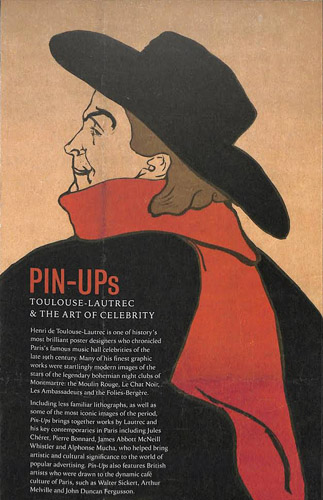|
PIN-UPS: TOULOUSE-LAUTREC AND THE ART OF CELEBRITY
An exhibition at the Scottish National Gallery,
PIN-UPS: TOULOUSE-LAUTREC AND THE ART OF CELEBRITY
Edited by Hannah Brocklehurst and Frances Fowle
National Galleries of
As the introduction to the excellent catalogue for this exhibition
points out, a “culture of celebrity” is not something that suddenly
appeared around the mid to late-twentieth century when the world of
pop began to demonstrate how important publicity was to the success
of many musicians and singers. Back in the
In
The fact is that faded photographs, scratchy recordings, and a few
similar mementos apart, little exists of the work of most of the
performers to persuade us that they were as good as contemporaries
claimed them to be. We rely on the posters to recreate what we
imagine they were like. Interestingly, the value of many of the
posters as art, and not merely as advertisement, seems to have been
recognised almost from the start as technical innovations, and a
loosening of licensing laws, caused them to proliferate. People went
out and stripped them from walls and hoardings almost as soon as
they were put up. Exhibitions of poster art were organised, dealers
began to specialise in them. The first poster exhibition took place
in Paris in 1884, and a major one In London in 1894/95. I don’t
think we ever had any poster artists in this country to compare with
Lautrec, Jules Chéret, and Théophile-Alexandre Steinlen. They were
among the leading names, along with Alphonse Mucha, who largely
specialised in advertising Sarah Bernhardt, but many other artists
produced posters, if not to the same degree as Lautrec. Pierre
Bonnard is an example. Designing posters presumably paid reasonably
well and could help support struggling younger artists.
It is Lautrec who occupies the key role in the exhibition, and more
than a few of his best-known posters can be seen on its walls.
Aristide Bruant, Yvette Guilbert, La Goulue, and Jane Avril. They’re
all there. He also portrayed some lesser-known performers, such as
May Milton and May Belfort. The latter had a brief success with the
song, “Daddy Wouldn’t Buy me a Bow-Wow”, though her career failed to
develop after that. If the song is ever heard now I doubt that many
people will know who first sang it. As for May
There are other posters and paintings in the exhibition that are
well worth mentioning. Jules Chéret’s design for LoÏs Fuller’s
appearance at the Folies Bergère is eye-catching. Fuller, an
American, specialised in dancing while “dressed in reams of white
silk, with wands sewn inside the sleeves, she would swirl the fabric
to create spectacular sculptural forms”. Henri-Gabriel Ibels’ poster
for “the popular entertainer Jane Debary” is less colourful than
Lautrec and Chéret, but is still striking. And Steinlen’s brilliant
poster, “Cabaret of the Chat Noir with Rudolph Salis”, is a
stand-out item. He amusingly mocked Alphonse Mucha’s liking for the
halos he often placed around the heads of his females by showing his
cat with one.
Two small, but typical Daumier lithographs, a 1930s painting by
Sickert of high-stepping chorus girls, and his early 1900s, “The Old
Bedford”, a music-hall he frequented, and several works by the
Scottish colourist, John Duncan Ferguson are bonus items. I was
particularly taken by
Pin-Ups: Toulouse-Lautrec & the Art of Celebrity
doesn’t break any new ground, but it is a thoroughly entertaining
and in some ways instructive exhibition. The emphasis is obviously
on personalities, but posters also played a key role in advertising
products. Bonnard’s poster promoting a brand of champagne is a
notable example.
|
